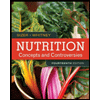Population Ecology Lab Report
docx
keyboard_arrow_up
School
Dallas County Community College *
*We aren’t endorsed by this school
Course
1409
Subject
Biology
Date
Feb 20, 2024
Type
docx
Pages
6
Uploaded by SargentBadgerPerson715
Your preview ends here
Eager to read complete document? Join bartleby learn and gain access to the full version
- Access to all documents
- Unlimited textbook solutions
- 24/7 expert homework help
Your preview ends here
Eager to read complete document? Join bartleby learn and gain access to the full version
- Access to all documents
- Unlimited textbook solutions
- 24/7 expert homework help
Recommended textbooks for you



Nutrition
Health & Nutrition
ISBN:9781337906371
Author:Sizer, Frances Sienkiewicz., WHITNEY, Ellie
Publisher:Cengage Learning,

Nutrition: Concepts and Controversies - Standalo...
Health & Nutrition
ISBN:9781305627994
Author:Frances Sizer, Ellie Whitney
Publisher:Brooks Cole


Essentials Health Info Management Principles/Prac...
Health & Nutrition
ISBN:9780357191651
Author:Bowie
Publisher:Cengage
Recommended textbooks for you
 NutritionHealth & NutritionISBN:9781337906371Author:Sizer, Frances Sienkiewicz., WHITNEY, ElliePublisher:Cengage Learning,
NutritionHealth & NutritionISBN:9781337906371Author:Sizer, Frances Sienkiewicz., WHITNEY, ElliePublisher:Cengage Learning, Nutrition: Concepts and Controversies - Standalo...Health & NutritionISBN:9781305627994Author:Frances Sizer, Ellie WhitneyPublisher:Brooks ColeEssentials Health Info Management Principles/Prac...Health & NutritionISBN:9780357191651Author:BowiePublisher:Cengage
Nutrition: Concepts and Controversies - Standalo...Health & NutritionISBN:9781305627994Author:Frances Sizer, Ellie WhitneyPublisher:Brooks ColeEssentials Health Info Management Principles/Prac...Health & NutritionISBN:9780357191651Author:BowiePublisher:Cengage



Nutrition
Health & Nutrition
ISBN:9781337906371
Author:Sizer, Frances Sienkiewicz., WHITNEY, Ellie
Publisher:Cengage Learning,

Nutrition: Concepts and Controversies - Standalo...
Health & Nutrition
ISBN:9781305627994
Author:Frances Sizer, Ellie Whitney
Publisher:Brooks Cole


Essentials Health Info Management Principles/Prac...
Health & Nutrition
ISBN:9780357191651
Author:Bowie
Publisher:Cengage